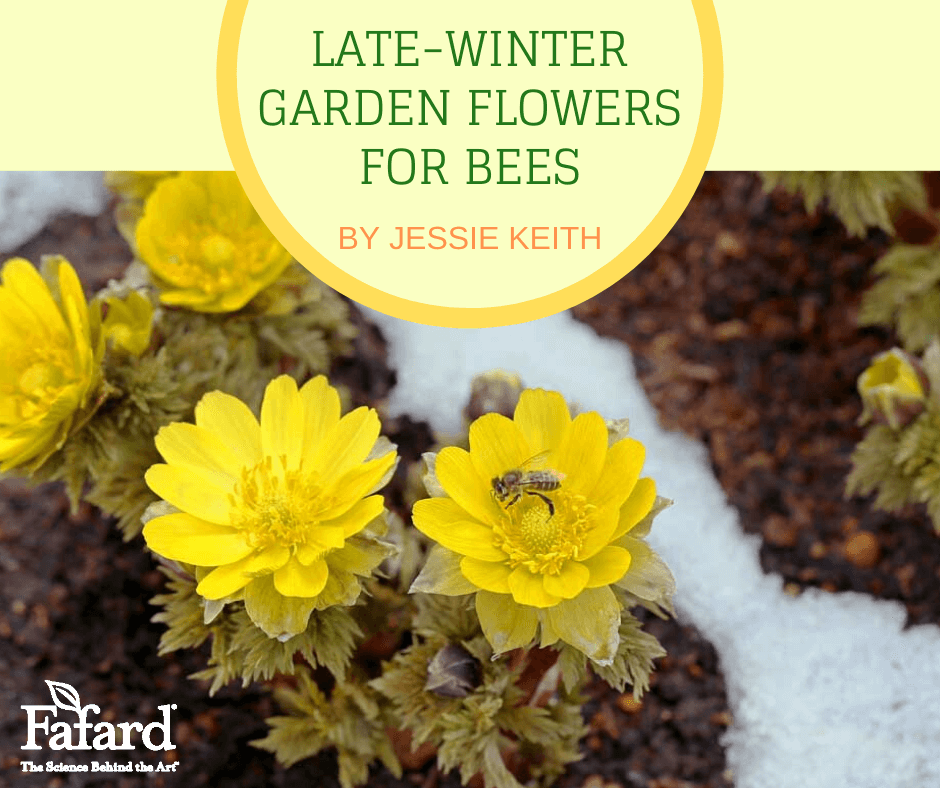

The late-winter blooms of glistening snowdrops, golden witch hazel or the earliest crocuses are all bee-pollinated. Most of the first American woodland wildflowers are also pollinated by native bees. These pretty flowers are vital early forage for bee populations everywhere, which is why they should be a part of our spring gardens.
How Honeybees Beat Winter Cold

Bees cannot regulate their own body temperature. That means when it’s very warm they are most active, and as temperatures drop, they slow down and become unresponsive. The perfect temperature in a honeybee (Apis mellifera) hive is 95 degrees F, and at just 55 degrees F honeybees can no longer fly well. But, they never go dormant. They have found ways to keep themselves warm in the hive, even on very cold winter days, so they can immediately start flying to find nectar on a chance warm late-winter day when early flowers begin to appear. This helps them supplement waning stores of honey and stave off potential starvation.
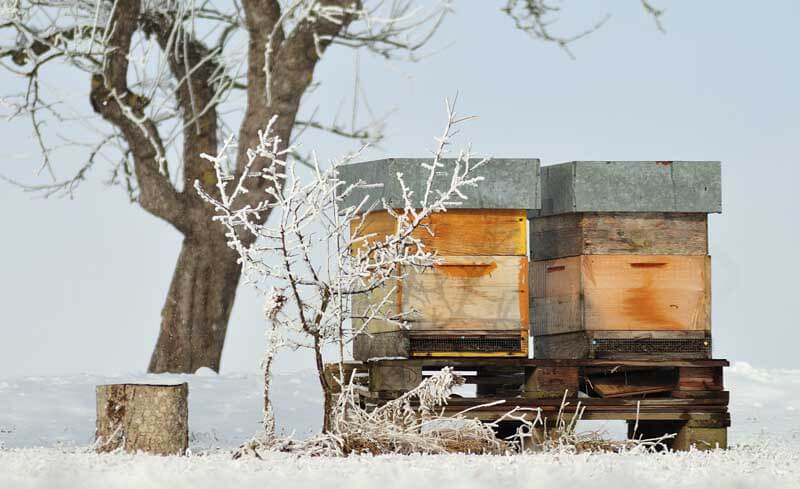
When temperatures drop, honeybees cluster in the hive around the queen. When temperatures head toward freezing, the bees closest to the queen begin to vibrate their wings and abdomens to physically create heat by friction–kind of like rubbing two pieces of wood together to create a fire. The bees on the outside of the cluster huddle tight, and still as insulation. This keeps hive interiors warm and bees ready for action.
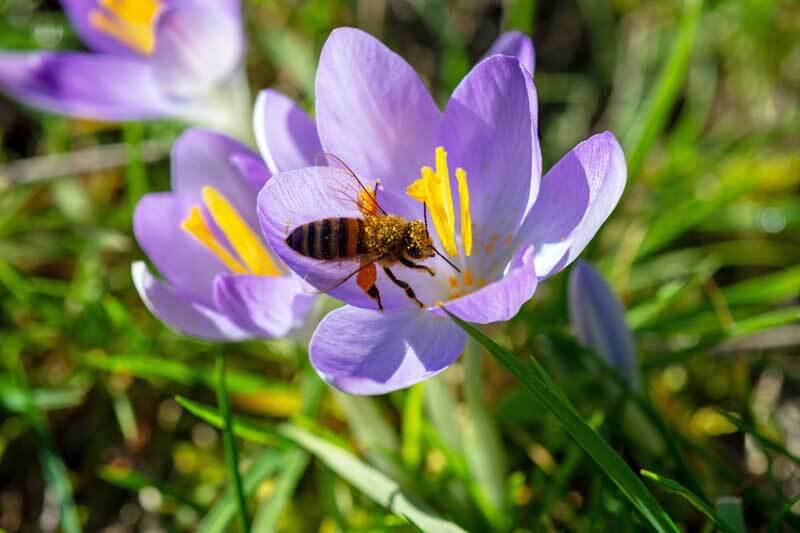
Spring flowers also help out! Some actually act like little greenhouses and warm up several degrees for bees. These blooms lay low to the ground, face upwards, are reflective, and track or catch the sun, which allows the temperature within each blossom to be a little higher. So, at each visit, the bees warm up a little. These mini-greenhouse flowers include adonis, crocus, and daffodils.
The First Bee Blooms
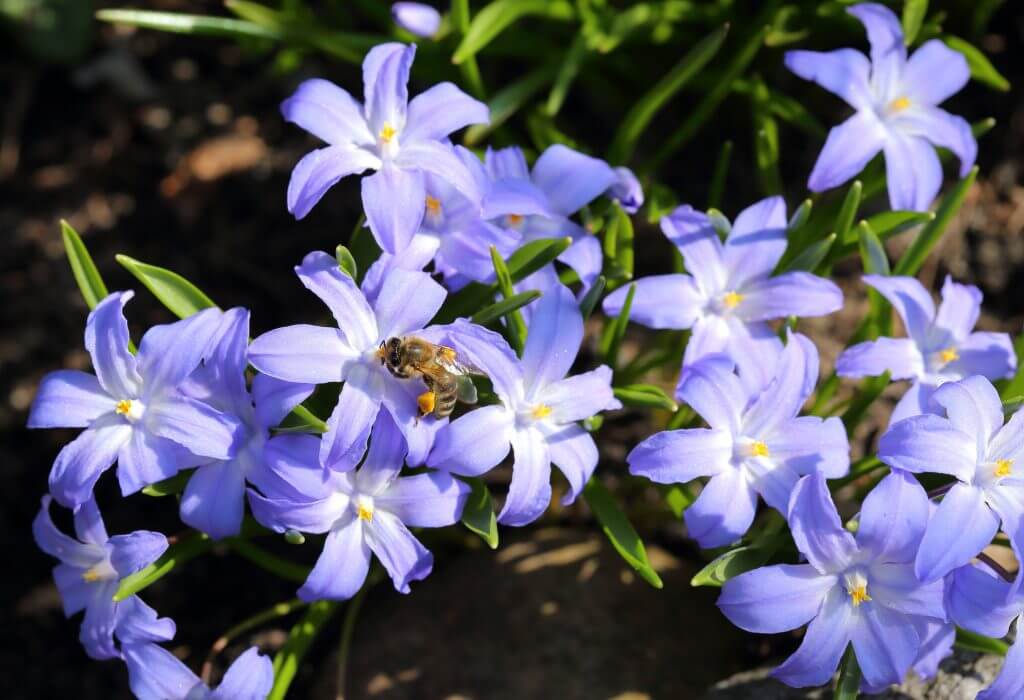
Most of these are bulbs and wildflowers, but some bee-favored blooms appear on shrubs. Bees are most attracted to fragrant flowers with blooms or nectar guides of yellow, blue, or ultraviolet shades. That’s why so many bee flowers are yellow or blueish-purple. (Click here to learn more about the flower cues that attract bees and other pollinators).
Late-Winter Bee Flowers

The small, bright yellow blooms of Amur Adonis (Adonis amurensis, Zones 3-7) are some of the first garden flowers to appear, sometimes flowering as early as January during warmer winters. Their clear, golden flowers have many petals, reach just several inches high, and rise above attractive ferny foliage. The leaves will disappear a couple of months after flowering. Winter aconite (Eranthus hyemalis, Zones 3-7) is similar, but it only reaches a few inches, has fewer gold petals, and naturalizes over time. Plant very early daffodils (Narcissus hybrids, Zones 4-8), such as ‘Jetfire’ and ‘February Gold’, alongside these and look for bees on their sun-drenched blossoms.
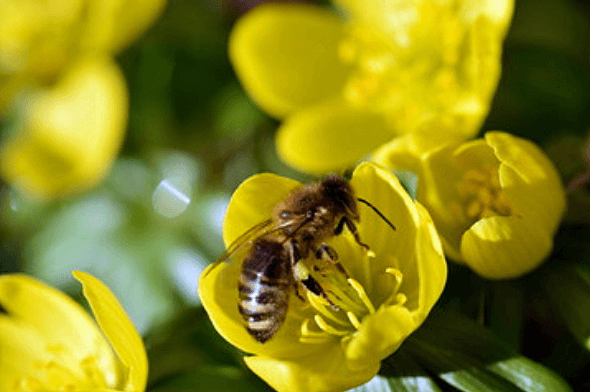
Many little blue bulbs (4 to 8 inches) are all charming, naturalize, and provide essential bee forage in January, February, or March, depending on your zone. Siberian squill (Scilla siberica, Zones 2-8) with its nodding little bells of the richest violet-blue, has equally blue pollen, which is a fun site to see on a bee pollen basket. The flowers of glory-of-the-snow (Chionodoxa luciliae, Zones 3-8) look a little similar, but they are infused with white, upward facing, a little larger, and have yellow pollen. The even larger flowered Jessie spring starflower (Ipheion ‘Jessie’, Zones 5-9) is a bit taller (8 to 12 inches) and has the deepest blue starry flowers and looks very pretty alongside classic, super fragrant, violet-purple grape hyacinth (Muscari armeniacum, Zones 4-8), which blooms in earliest spring. (Click here to read more about grape hyacinths.) Plant all of these among the violet-blue, pink, or white daisy-like flowers of Grecian windflower (Anemone blanda, Zones 5-8) and woodland crocus (Crocus tommasinianus, Zones 3-8), which all bloom at the same time and attract bees just as powerfully
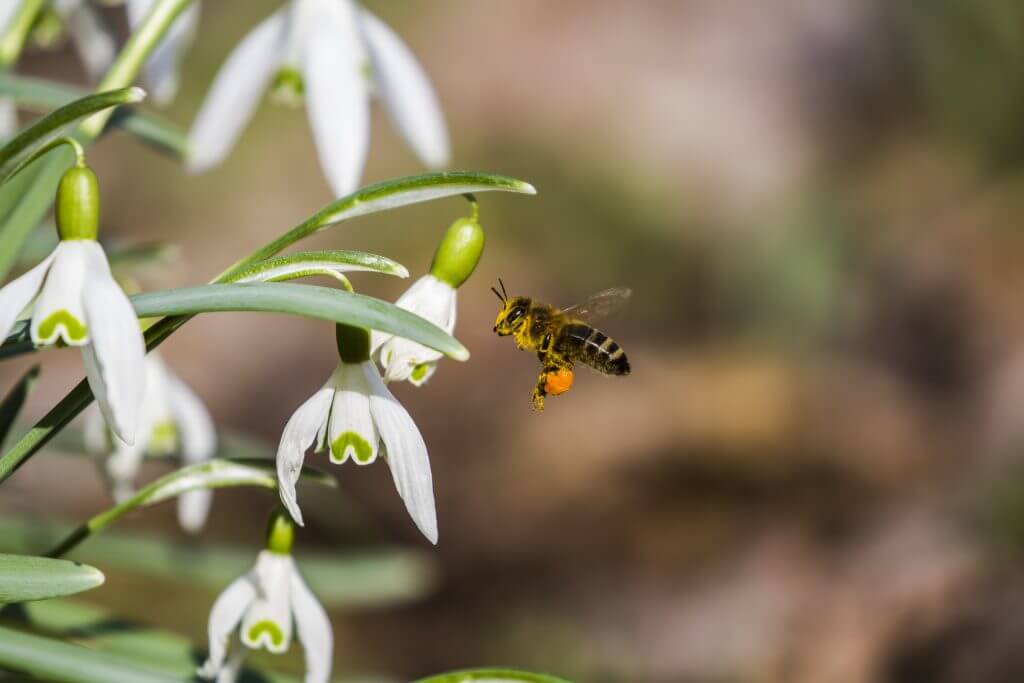
White, nodding snowdrops (Galanthus spp.) of all kinds bloom as early as December or January during very mild winters and attract bees to their sweetly scented flowers in flight. The simple, easy bulbs naturalize in small sweeps and resist late snowfall with ease.
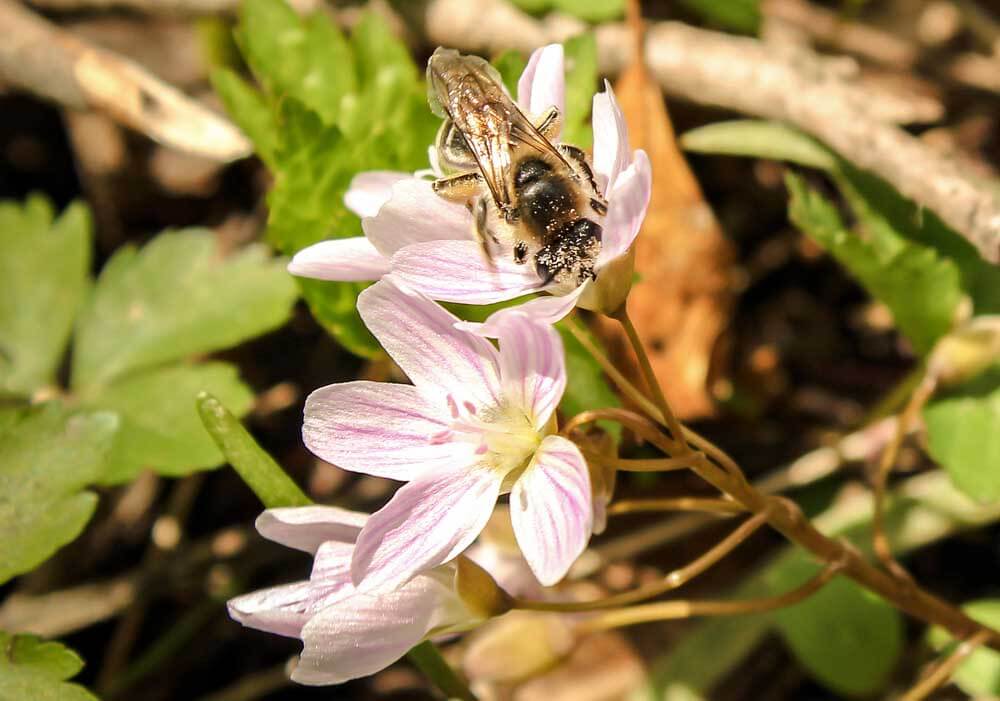
Some North American native spring wildflowers are essential for native bees. Spring beauties (Claytonia virginica, Zones 3-8) with their tiny pink and white striated flowers, are some of the most important. They create vast sweeps of tiny flowers that bloom in the latest months of winter. The feathery-leaved Dutchman’s breeches (Dicentra cucullaria, Zones 3-7) is another, which has delicate stems dotted with little v-shaped flowers of white. Early bumblebees find them irresistible. The yellow-flowered American trout lily (Erythronium americanum, Zones 3-8) with its flared, yellow, lily flowers and spotted foliage, is another to draw many early bees.
Late-Winter Bee Shrubs
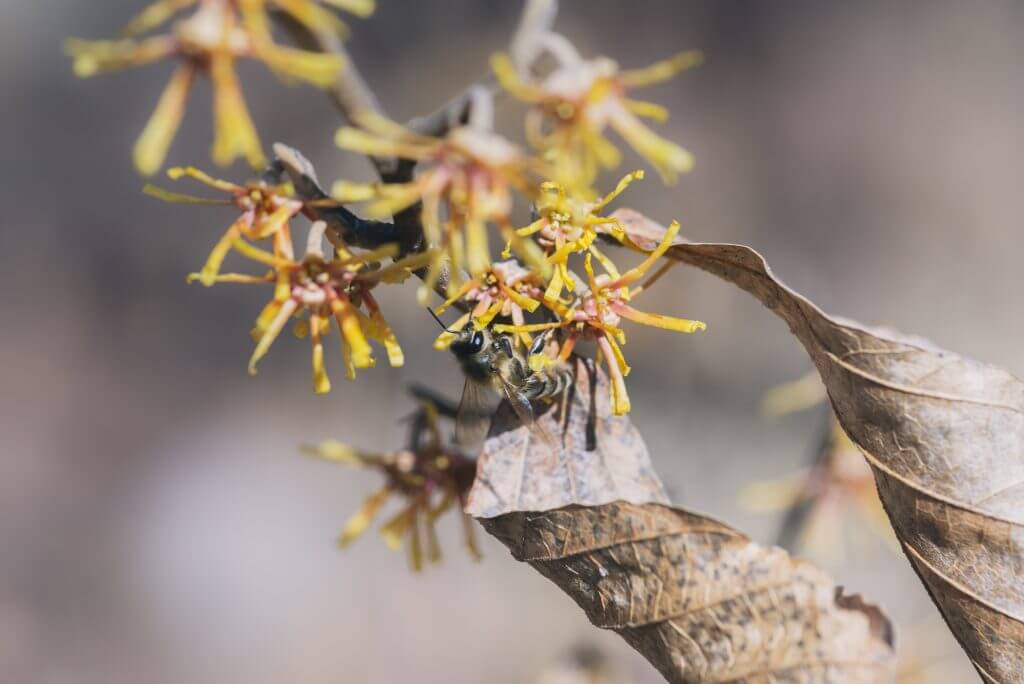
Hybrid winter witch hazel (Hamamelis x intermedia, Zones 5-8) has the most exciting varieties to offer with flowers of yellow, orange, or rusty red. Even though they often bloom in January or early February, bees are drawn to their highly fragrant flowers. Cornelian cherry (Cornus mas, Zones 4-8) has a comparable habit, golden flowers, and bloom time with the added benefit of edible fruits in summer, which are relished by birds. The common Forsythia (Forsythia x intermedia, Zones 5-8) is another first-bloomer for bees that is easy to grow if given lots of sunlight. Their golden flowers are well-known and admired.

All of these shrubs can be planted in fall or spring and appreciate a good helping of Fafard Premium Natural & Organic Compost amended into the backfill at planting time.
Even a few of these flowers will make your winter landscape glow with color. And, the fact that they are some of the first flowers to feed bees makes them that more desirable and welcoming in the garden.


